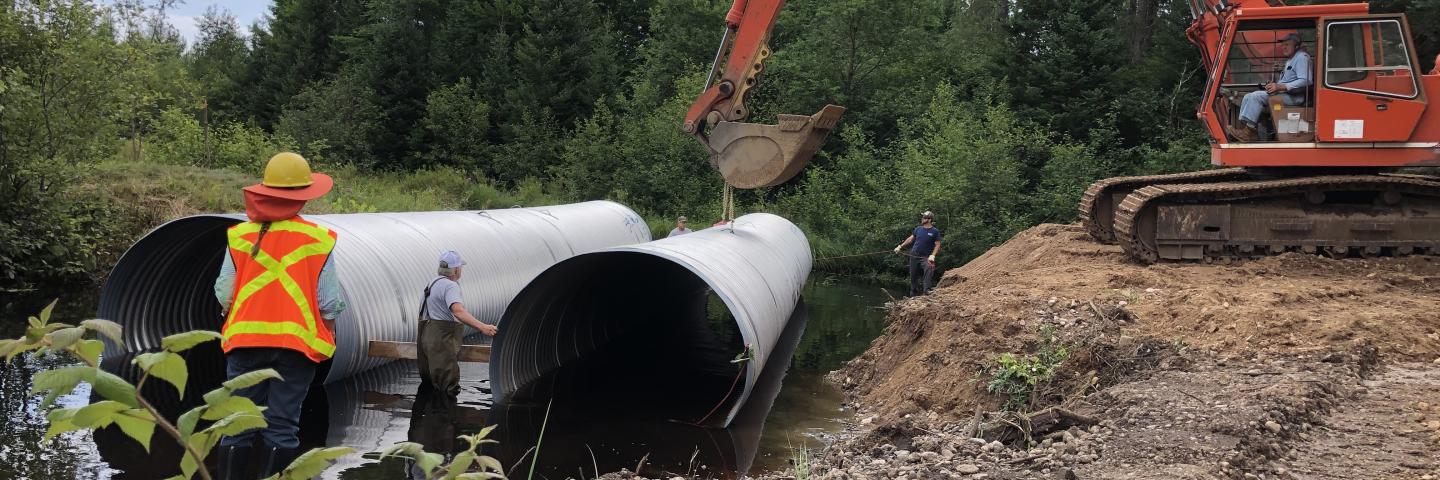Stream Crossing Improves Ability to Manage Forest

Former Wisconsin DNR Forestry Technician, Roy Gilge, partnered with NRCS to overcome a persistent roadblock, with help from his family, friends, and 5 different practices funded by the Environmental Quality Incentives Program, allowing for more successful forest management.
Background
Roy Gilge, a logger and former Wisconsin Department of Natural Resources (WI DNR) Forestry Technician, passed down his penchant for life-long land management to his son Mathew. The Gilge family owns 200+ acres in Price County, Wisconsin, which provides plenty of management and recreation opportunities for father and son. Damaged in a 2010 storm, a stand of timber on their property west of Price Creek was inaccessible without a temporary bridge used during the coldest parts of the winter. The site location had a history of a previously constructed crossing, but Roy needed a better way to access the stand for an upcoming scheduled harvest per his Managed Forest Law plan with WI DNR.
Before and after photos of the stream crossing location.
Highlights
Mathew completed an application and was awarded a contract through the Environmental Quality Incentives Program (EQIP). Through a partnership agreement between the Natural Resources Conservation Service (NRCS) and the Department of Agriculture Trade and Consumer Protection, the design was completed with the help of Cody Overgard, WI NRCS Civil Engineering Technician. With an approved stream crossing design, and many conversations with WI DNR, Roy and Mathew were approved for a permanent stream crossing permit.
Several conservation practices were implemented in the Gilge property project, including Stream Crossing, Access Road, Obstruction Removal, Mulching, and Critical Area Planting. The access road and culverts used for the stream crossing were designed to support the large equipment that would be used during logging practices. Cody designed the crossing to have a long flat portion of the middle of the crossing to allow for logging trucks to flatten out before climbing the hills on either side of the crossing. “The approach to the crossing needed to have enough height to ensure proper ingress and egress for the 80,000 lbs. log trucks,” Cody explained.
The obstacle of placing the culverts in such a remote location proved to be a challenge, but Roy and his good friend were able to successfully place them properly on the first attempt. A plethora of erosion matting and a seed mix would allow for vegetation to grow and hold soil in place on the banks of the crossing. Multiple diversions were put in place to divert surface water away from entering the stream directly.
On working with WI NRCS, Roy stated, “everybody was very good to work with, Melissa Knipfel (WI NRCS Resource Conservationist), Cody Overgard and Mary King (WI NRCS Engineer)—I can’t say enough good. It sure turned out well.”
The effort of the well-rounded team of Melissa leading the contract and planning portion, Cody’s design, and Mary King and Klayton Kree (Soil Conservation Technician with Golden Sands Resource Conservation & Development) inspecting construction, made for the completion of a sound project.
Future Plans
Roy and his family have plans to continue with forest management on the property following their forest management plan. During the winter of 2021-2022, Roy was able to continue logging and send trucks full of Ash logs to the mill.
Additional Information
Environmental Quality Incentives Program - Wisconsin
The Environmental Quality Incentives Program (EQIP) provides financial and technical assistance to agricultural producers and non-industrial forest managers to address natural resource concerns.
Learn More
